Plano Prairie Garden alight with fall color
Sometimes you just luck into a great garden visit. Last weekend my family and I drove up to Dallas for the state fair, staying overnight at my father-in-law’s house in Richardson, a northern suburb. The day we left Austin I realized that we would be staying very close to Plano, another Dallas suburb, so I contacted Michael McDowell of Plano Prairie Garden, a blog I’ve been following for a couple of years, and asked if I could pop by. Oh, and could it be at 8 a.m. on Sunday (before my family got going for the day)? A good sport, Michael agreed, and so I found myself driving up to his suburban home, an island in a sea of traditional lawns, where his gorgeous garden was in full fall bloom in the magical light of early morning. How lucky can you get?
Michael’s prairie garden is an anomaly in his neighborhood, which is ironic considering the neighborhood’s name, Prairie Creek. He began digging out his St. Augustine/Bermuda lawn when he moved in, about 7 years ago, gradually expanding from the foundation to the curb. Today his front and back yards are lawn-free, with decomposed-granite paths running through prairie-style gardens. Only a narrow carpet of lawn grass remains, in a skinny side yard and along the alley where he parks, and I have a feeling its days are numbered.
The largest part of his garden is 3 years old, the “leaping” year according to gardening lore. Even after this summer’s terrible heat and ongoing drought, with a watering regimen of once every 7-10 days, his xeric garden was full and flowery. Recent cooler weather and 4 inches of rain prompted it to burst into bloom, just in time for my visit! Lucky, right?
The purple spires of gayfeather (Liatris mucronata or punctata) may have been the star of the show, although they had serious competition from the salvias, not to mention the ornamental grasses.
The coppery, upright foliage of little bluestem (Schizachyrium scoparium) threads its way through the front garden, adding continuity, texture, and fall color. Michael said it’s half the height it normally would be because of the drought, but I liked the small size. Hot-pink Autumn sage (Salvia greggii) looks especially pretty next to it.
In a wider view, you can see liatris in front and a glowing pink agastache behind.
A close-up of the agastache
Rich purple wands of liatris add vertical spikiness.
Michael uses succulents like this pale-leaf yucca (Yucca pallida) and spineless prickly pear (Opuntia) to add evergreen structure, which anchors all his billowing, fine-leaved perennials.
Opuntia, little bluestem, Salvia coccinea, and pale-leaf yucca
Close to the house, Michael recently added an Austin-style feature: a stock-tank bog planter filled with horsetail (Equisetum hyemale). Michael said one of his neighbors remarked skeptically that maybe it should have stayed in Austin. Naturally, I loved it.
I also love this picture because it captures the prairie gardener himself reflected in a window. He was standing beside me as I snapped away, thinking to stay out of the frame—ha! The beautiful grass in front is pine muhly (Muhlenbergia dubia), a native grass from west Texas.
Salvia coccinea and Yucca pallida
Magical morning light
A tighter view
And looking down you see mealy blue sage (Salvia farinacea) with pink skullcap (Scutellaria suffrutescens) behind it.
Cheerful, petite, nearly ever-blooming hymenoxys (Tetraneuris scaposa) catches the sunlight.
More liatris, with Salvia greggii behind and Gregg’s mistflower (Conoclinium greggii) in front
Monarchs love Gregg’s mistflower at this time of year.
Michael’s small back garden blazed with fiery Salvia coccinea, a sight sure to delight any straggler hummingbirds on their way south.
We spotted this queen butterfly on a shoulder-high frostweed (Verbesina virginica).
On first glance I thought this was a kidneywood tree (Eysenhardtia texana) in full bloom, but Michael informed me that it’s beebrush (Aloysia gratissima). Both are honeybee-attractors, and they have a similar airy habit and tiny, white flowers.
Fall aster (Aster oblongifolius) will bring in the bees too.
Other beneficial insects are also welcome in Michael’s garden, like this wasp on goldenrod (Solidago).
Faded chocolate daisies (Berlandiera lyrata) are as beautiful as fresh ones, to my eyes.
Fragrant mistflower (Eupatorium havanense), also known as shrubby white boneset, was covered with buds. This is a Halloween bloomer in my garden, and its ghostly white flower clusters attract butterflies by the dozens.
Hercules’ club tree (Zanthoxylum clava-herculis) was new to me. I like its glossy, notched leaves, but watch out for those thorns that give this plant its name.
Michael transplanted aggressively spreading snake herb (Dyschoriste linearis) from another part of his garden into his hell strip in early summer, and it quickly colonized this difficult area. It dies back in winter, he told me, and he whacks it back before spring to neaten it up.
Michael generously shared several plants with me, including a good-sized pine muhly, with which I’m not as familiar as Lindheimer’s and Gulf muhly. Pine muhly was one of his best-performing grasses during this challenging summer, he told me, along with bushy bluestem, little bluestem, and seep muhly. (I didn’t notice any Mexican feathergrass in Michael’s garden.) Indian grass (Sorghastrum nutans) suffered badly from the drought, and he said he’ll be pulling it out.
Thanks to Michael, I learned about several native Texas plants I’d not encountered, and saw firsthand the beauty of a prairie garden and just how much life it attracts compared to the lawn deserts that surround it. His design sense (repetition of plants, use of structural plants, well-designed and generous paths) impressed me too. He mentioned that he doesn’t always get it right the first time, but he’s not afraid to move plants around until it looks right. I asked if he ever just sat in his garden to admire it, especially at this time of year, but like most gardeners he just laughed and asked, “Sit?”
I also admired his fearlessness in trying something new. Before moving to his current home, Michael had a garden where he grew a lot of antique roses. But he wanted to try a prairie garden here, with mostly native plants that would attract wildlife (a quality roses lack), and he threw himself into it, doing all the work himself a little at a time. He didn’t let a lawn-loving neighborhood aesthetic stop him either, although he does strive to keep things neater out front than in back for the sake of the neighbors. Now he reaps the rewards, with a low-water garden that is beneficial to wildlife and delightful to visitors as well. Thanks, Michael, for sharing your garden with me!
If you’d like to know more about Michael’s garden, visit his blog Plano Prairie Garden.
All material © 2006-2011 by Pam Penick for Digging. Unauthorized reproduction prohibited.


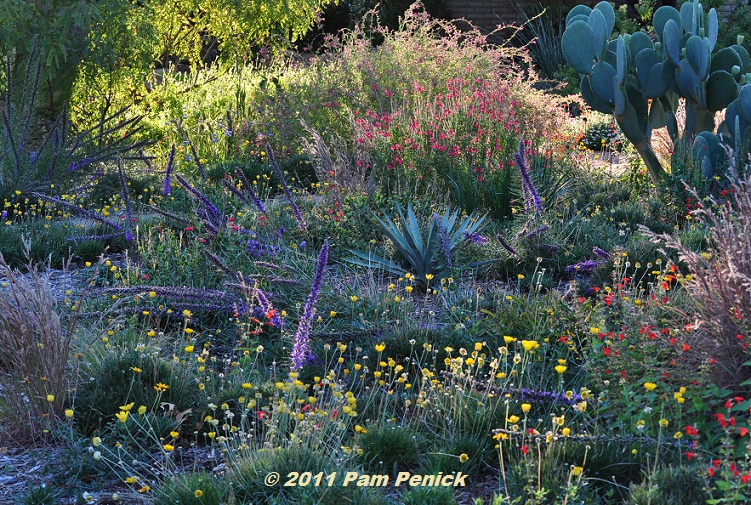
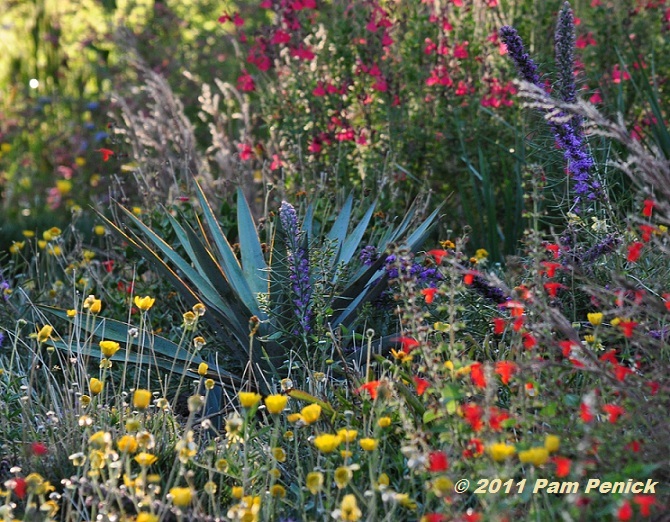
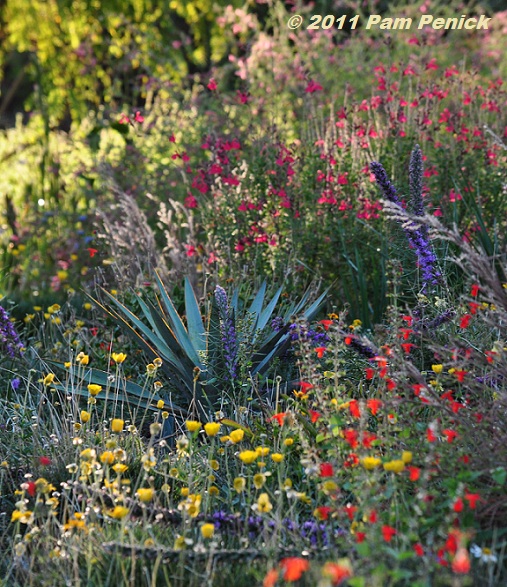
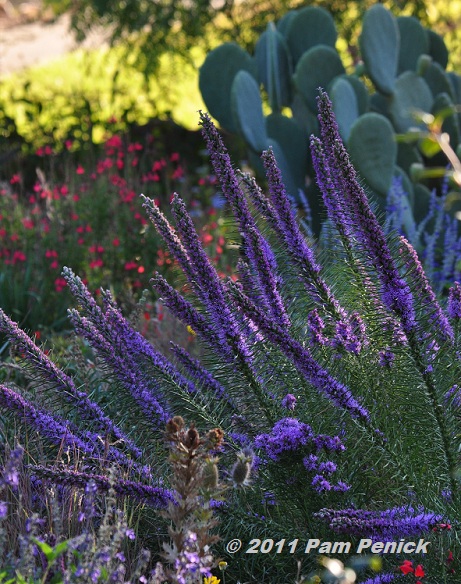
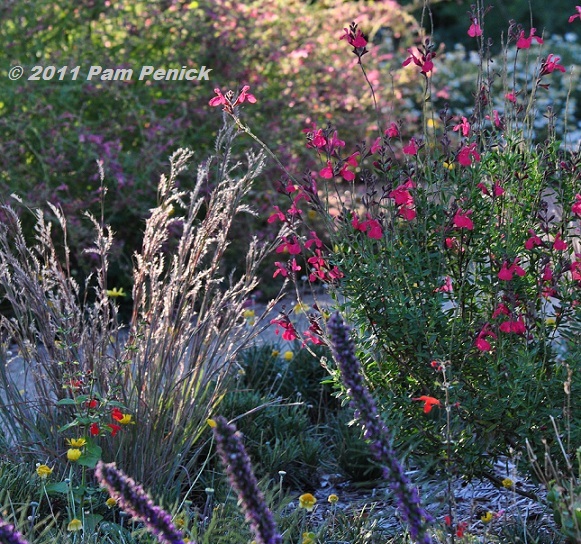
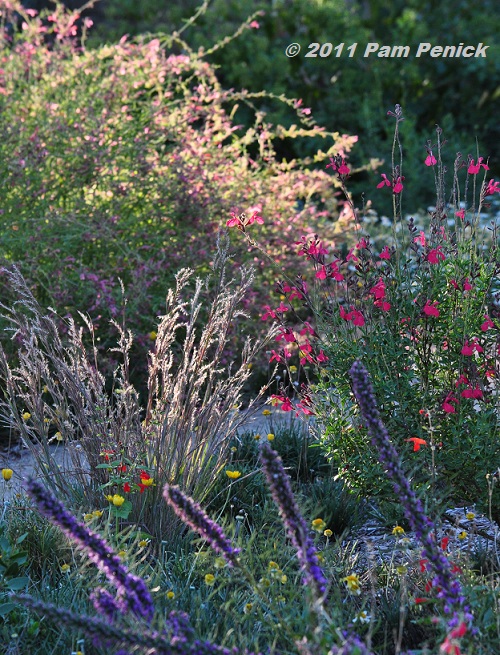
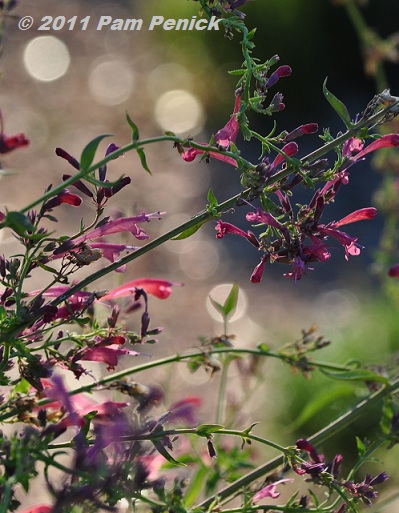
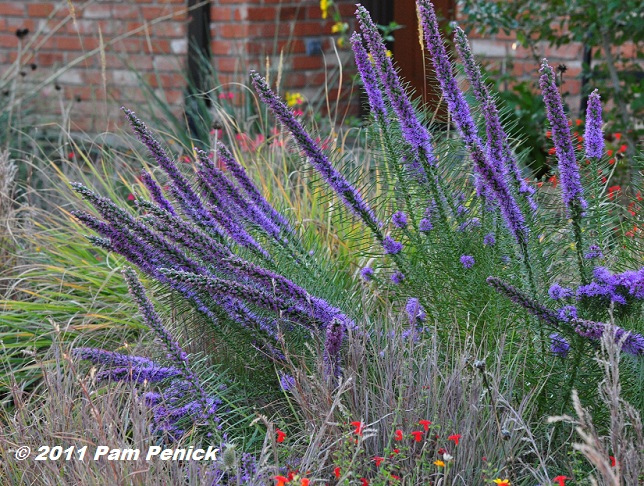
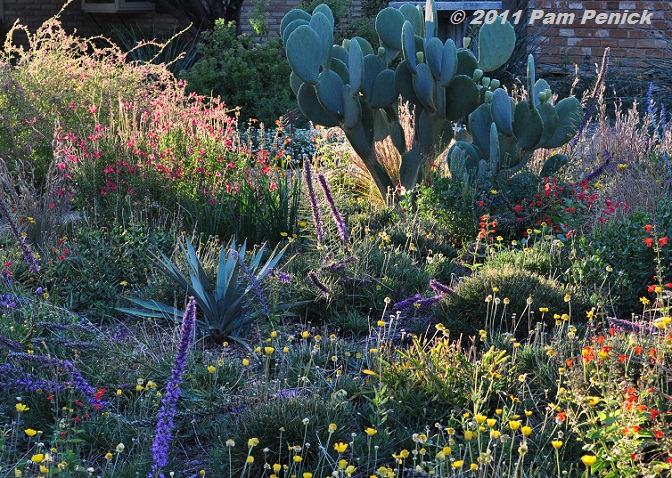
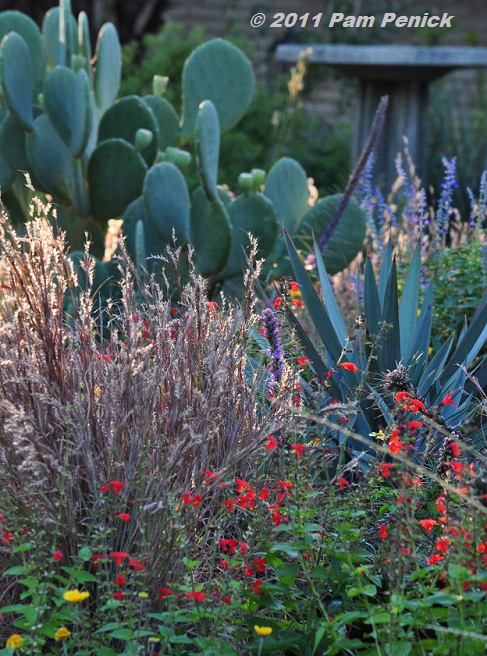
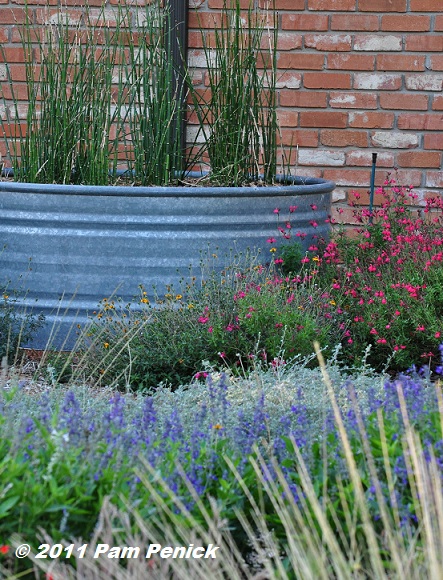
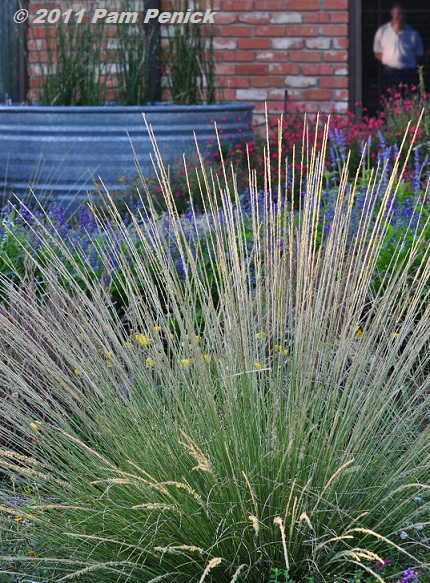
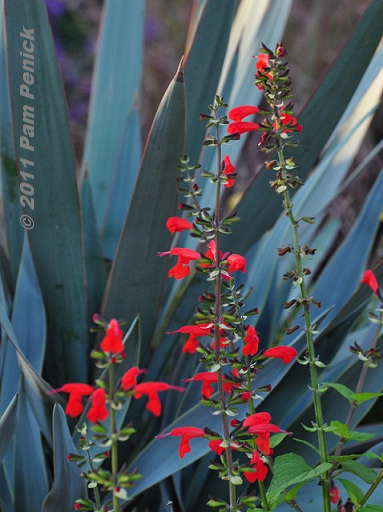
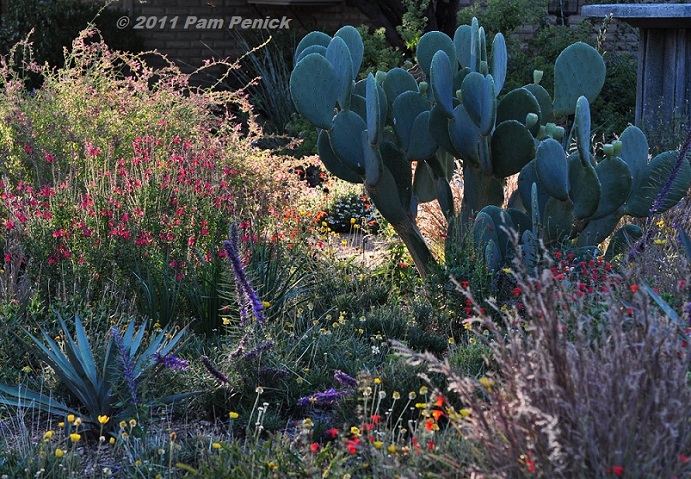
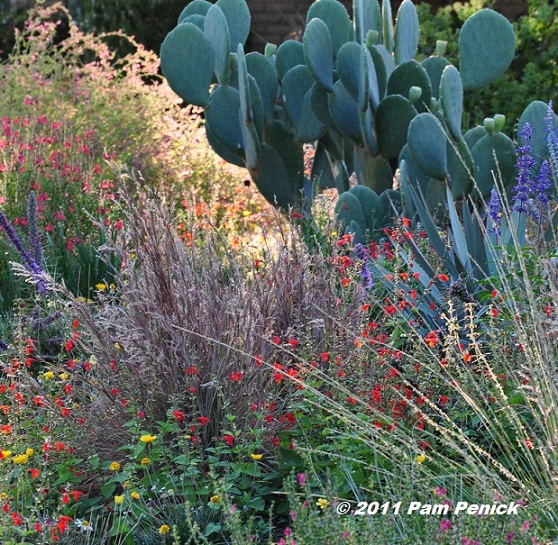
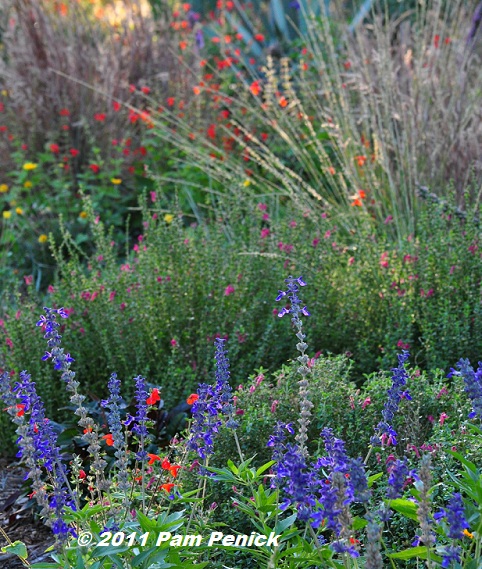
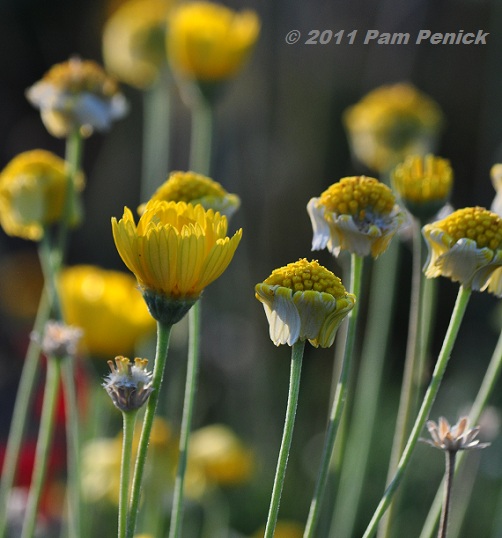
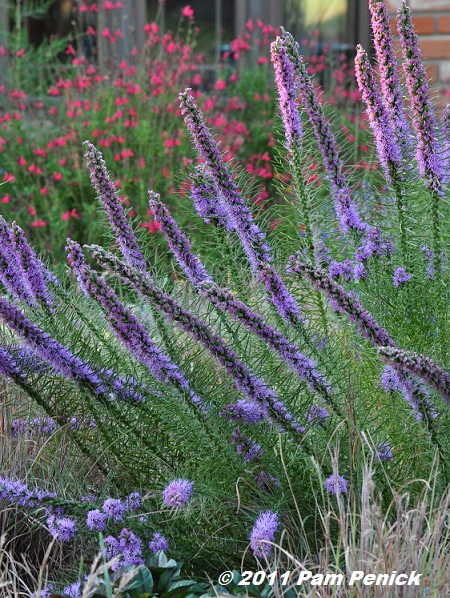
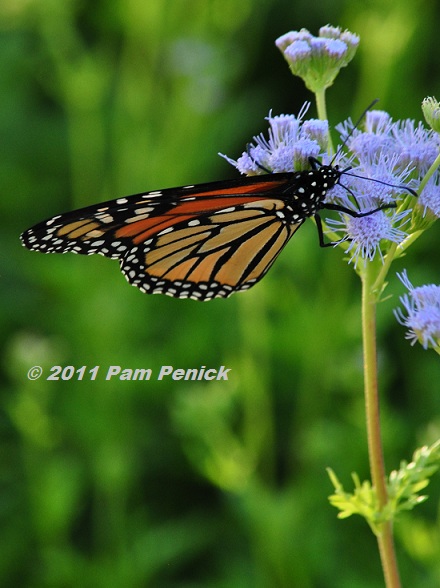
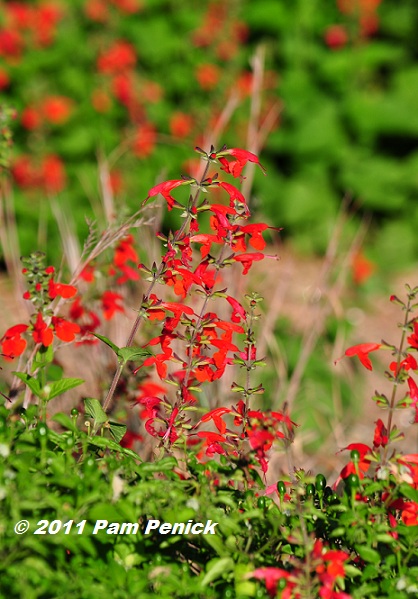
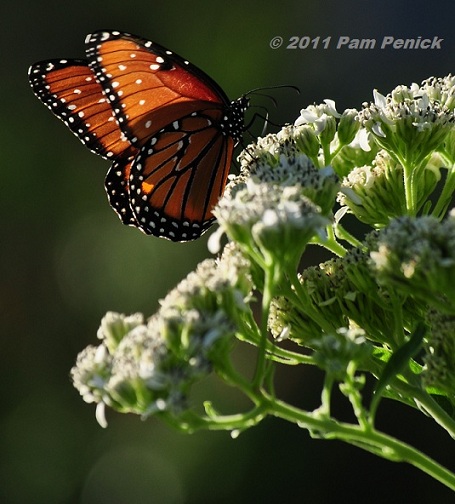
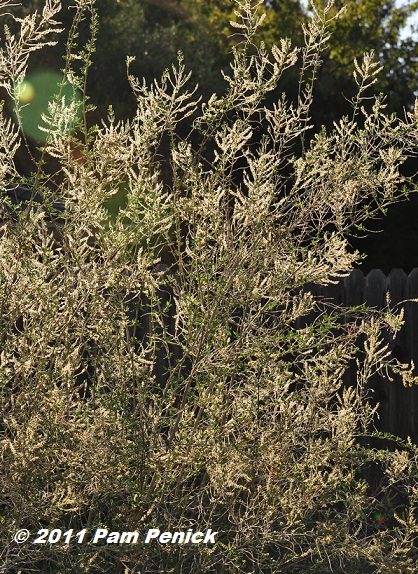
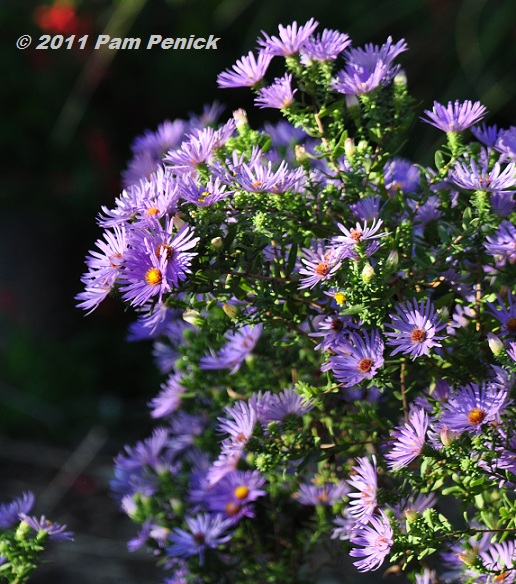
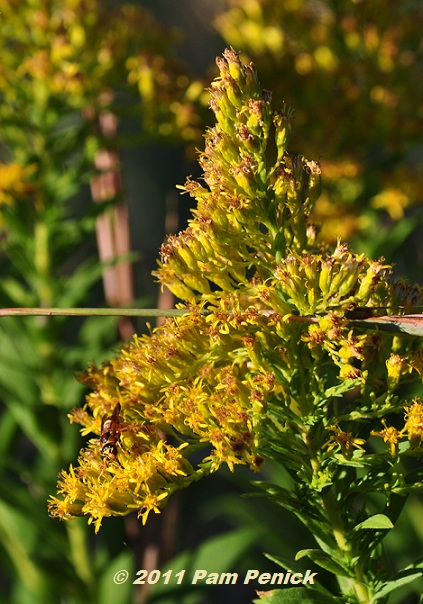
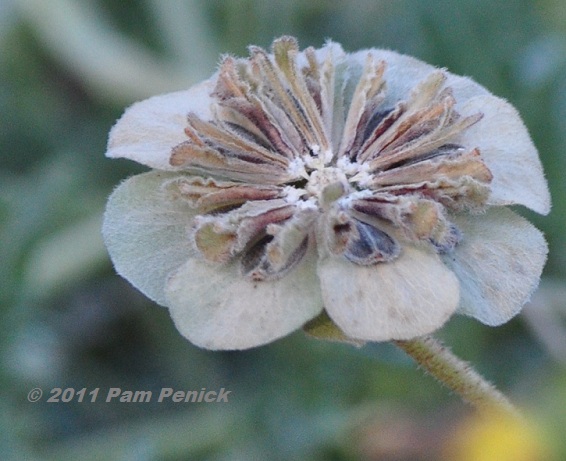
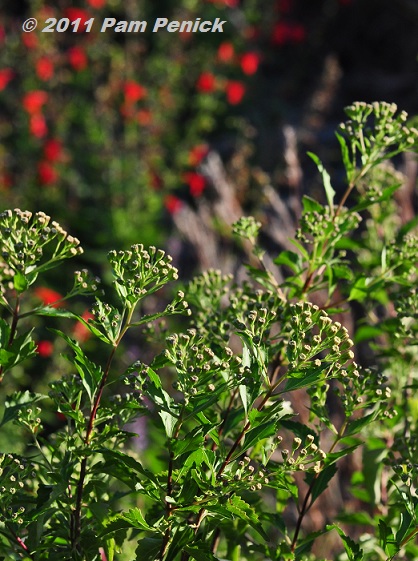
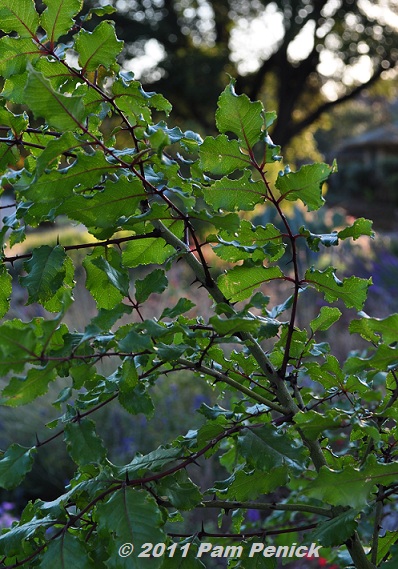
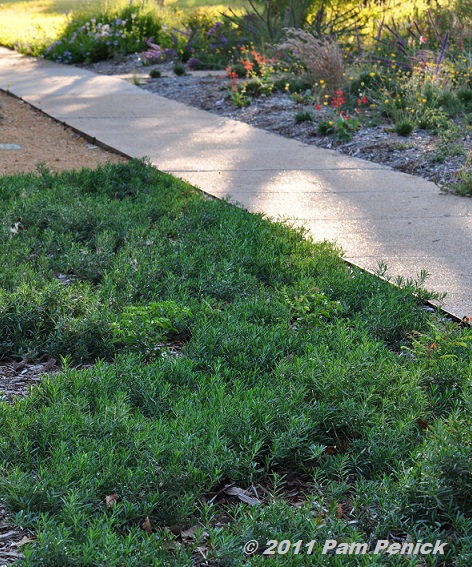
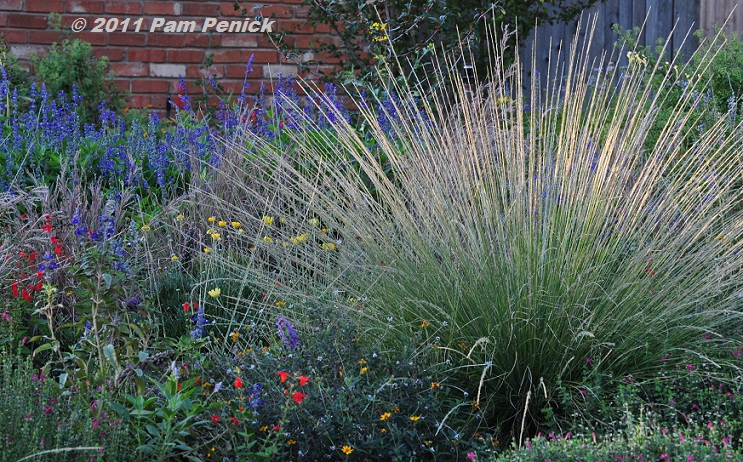
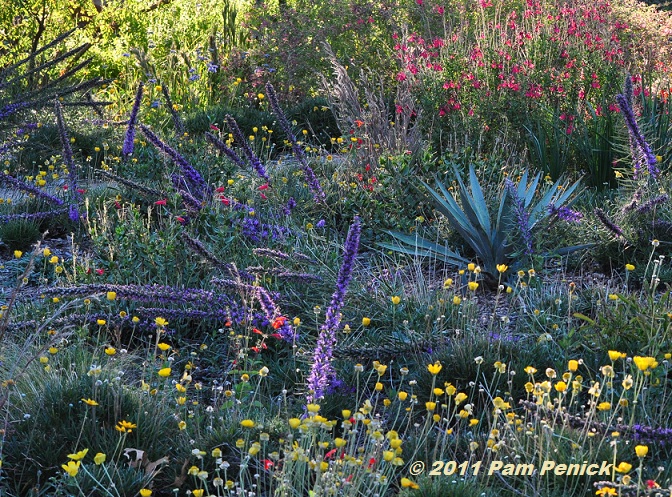

The 1st photo with ALL the variations on blues, and the morning light, really evokes the cool of the morning…right down to the fresh scents! Thanks for taking us to Dallas, even though not all admire your funky Austin accents…all I ever see of the place is from the air and the runways at Love Field.
You know, until this year I didn’t have much of a sense of Dallas gardens either, David. But I really enjoyed the Dallas Open Days tour last spring, and I really wanted to attend their water-wise tour right afterward but couldn’t swing two Dallas visits in a row. There seems to be lots of cool gardening going on up there. —Pam
Holy Moses! I LOVE that gayfeather! I have yet to find it in a local nursery. Maybe I’ve just been unlucky when visiting them? I really want some of this stuff. Maybe I’ll just have to order it from an online nursery like High Country Gardens or something.
Michelle, I’m sure I’ve seen gayfeather offered in Austin, maybe at Barton Springs Nursery? For sure you can buy seed packets at area nurseries. And I bet they sell it at the Wildflower Center’s twice-a-year plant sale, but you just missed the fall sale. —Pam
Wow, just wow! It’s wonderful to see such a beautiful garden through the lens of an especially appreciative visitor like you Pam.
Thanks to Mike and you, I’m definitely leaving some space for this in my plans.
You can see many of these plants in fall bloom at the Wildflower Center too, Shirley, if you’re looking for native-prairie inspiration. —Pam
Beautiful garden and photos. The liatris is magnificent. There used to be a great deal of liatris at the front garden at Gullett Elementary–I don’t know if it’s still there. And I love Little Bluestem–we don’t see it quite as much here in Austin as we should–it’s beautiful and tough. How lucky to visit that garden and thanks for sharing.
Like you, I don’t know why we don’t see little bluestem used more often in Austin, Tina. I’m a convert after seeing it in Michael’s garden. However, I have to admit the small, drought-stunted size appeals to me more than its usual height. When he told me it’s usually twice as tall in wetter years, it gave me pause. —Pam
Thanks for the tour of such a great garden. Liatris is a perennial I keep meaning to try for this zone 10, since I’ve read it doesn’t mind a mild, no-chill winter. Wonderful to see such masses of it! I wonder what it’s “footprint” is in terms of overall circumference of one plant and how much it splays outward. Great stuff, Pam!
Good question, Denise. Maybe Michael will give you an answer. I’d guess that it’s about 4 feet in diameter by the time it splays outward in fall, but of course sizes vary so much depending on climate and rainfall. One thing I do know is that it is more upright in lean, dry soil. Like so many xeric plants, it tends to flop on the ground when babied with excess water and compost. —Pam
I’m amazed by how large those Liatris are. Mine never get a chance to grow that big.
It all comes down to right plant, right place, doesn’t it? We’re all making adjustments all the time, but that’s the fun of it too. —Pam
That is a seriously gorgeous garden. The color and mix are beautiful and a showcase of native Texas plants. Did you take any long shots to give some perspective on the view from the street? I have lots of questions. Thanks for the link to his website.
Jenny, I wish I had taken more views, but I was so intent on shooting across the length of the garden to capture the morning light that I didn’t think of it (his garden faces north). Maybe you’ll find different views on his blog. —Pam
Wow, it truly is a magnificent garden. I scrolled up and down several times taking it all in! The colours, the textures, the planting choices are stunning.
Yes, it’s very nice indeed, and this was peak season for blooms after our long, dry summer. —Pam
So what would Michael say were his top 5 performers this summer?
ChrisF, see Michael’s comment below. —Pam
Wow, what a neat place. You are a lucky girl to see it in its glory.
Yes, I was! —Pam
Pam, the photos are great! I love your perspectives. I did not realize I was in that shot of the pine muhly. I was making sure my body and shadows were not in the shots and forgot about reflections.
I may have exaggerated a little about the size of the little bluestem during less stressful years. I checked some photos from last year and it may have been 6 inches taller than it was this year. Until this year, I was keeping them watered and fertilized to get them established. This year they are the size they would be on a real prairie.
I should clarify about the snake herb. I planted a four inch pot two years ago in the main part of the prairie and it quickly expanded to a three foot diameter. I was afraid it would take over the prairie, so this year I dug out that three foot plant and planted it in the parkway where it would have some boundaries. I spaced a couple of stems 6-8 inches apart. It filled in well in a short amount of time.
Denise asked about the Liatris. I have two plants that have been in the ground for 3 years. One measures 4.5 feet at the widest point. I suspect they will get wider each year. The smaller plants in the garden are two year old seedlings from the larger plants. This is their first year to bloom. They still have a single stalk. Pam, I should have yanked up a few of these for you.
ChrisF asked what my top 5 performers were this summer. It would be hard to narrow it down that much, but I did list about 30 winners that showed minimal stress in the October 16 post of my blog.
Thanks for the kind words and flattering photos (except for that last one). 🙂
Thanks for the additional info and clarifications, Michael. I’m glad you enjoyed the post. Thanks again for sharing your garden with me. —Pam
I totally love this garden! I’m so glad you got to see it in person. And outstanding photographs, as always. I nabbed three pine muhlys at the Wildflower sale and can only hope I can create something beautiful like this. Hope you got to have some fun State Fair nom noms too. What a fabulous trip!
Thanks, Linda. Oh yes, we did enjoy some fried nom noms at the fair: fried butter, fried cookie dough, fried Oreos, and fried Twinkies. Well, my son enjoyed those last two. But we left the fried beer and fried pizza for other brave fair-goers. —Pam
Pam you should be a professional garden tour guide. ha. Very well done.
Wouldn’t that be a fabulous job? Thanks for stopping by, Greggo. —Pam
Oh My! I love that pine muhly. I’ll have to look for it for my gravel garden, I wonder if it would like our PNW weather. Thanks so much for this wonderful look at a garden that is so different from what I’m used to seeing.
Michael told me the pine muhly likes good drainage, as one would expect with a plant from arid west Texas, New Mexico, and beyond. But after my summer visit to the Pacific NW, I’m convinced you guys can grow anything, even xeric plants, with proper drainage. I’d try it on a gravelly hill in your area, Alison. —Pam
Uhmm…this garden, or lawn. Why oh why would anyone prefer a lawn? Well done Michael!
Why indeed, Loree? There’s no comparison. —Pam
gorgeous electric blues in those shots… very nice!
I’m glad you enjoyed them, DGG! —Pam
Wow…very pretty. I looked at the photos yesterday and had to come back and look again because it is so pretty. I really like the gayfeather.
What a compliment, Amy—that you came back to look again. That gayfeather is very beautiful at this time of year. I’ve never tried it in my own garden but have admired it at the Wildflower Center many times. —Pam
What a great garden tour, Pam…and of one of my favorite blogs, to beat! You captured the whole mood and atmosphere so wonderfully…that morning light is amazing! I’ve been eyeing his Pine Muhly forever and pretty much had decided to get some for next year…now, I may have to add that Liatris to my list as well…looks like I’ll be encroaching on my neighbor’s property even sooner than I planned ;-)…JK!
I’m glad you enjoyed the pics, Scott. Yes, I could see both of those plants in your garden. How nice that you have extra room to plant next door. —Pam
I miss my liatris. It was such a strong performer in zone 5 – I always wished for a longer bloom season for it!
Maybe we enjoy them all the more for their transitory beauty? —Pam
Thanks for all the gorgeous photos of his garden. I follow Plano Prairie Garden and it’s on my favorites list as well. I lived up in Garland for an entire summer one year and I must say the Texas interior heat away from the Gulf Coast breeze gives me even more respect for gardeners up there. Humid with no breeze…it takes a brave soul.
I wish more of suburbia would try this. I have too much shade or I’d try a prairie garden here in Houston.
David/ 🙂
I have too much shade too, David, and I really miss my salvias from my old sunny garden. Ah well, we make the best of what we have, right? I’m glad you enjoyed the pics! —Pam
I love this garden and everything about the plants, structures, color combinations and textures. Your photos are wonderful and even though the colorful full frame photos are marvelous~I especially love the Tetraneuris scaposa. gail
Isn’t it the sweetest, sunniest little plant? I just added more to my back garden, Gail, but I’ve learned not to try it out front. The deer love it too. —Pam
STUNNING! Having grown up in Plano, I can totally sympathize with the plight of the creative gardener. Plano is a suburb’s suburb, where lush green lawns and perfectly shaped bushes are almost required. I’d love to see a wide-angle shot of the whole garden with the house, to see how the prairie lawn integrates with the suburban architecture. I’d love to be able to do what he has done in my own suburban yard. . .
Hi, Robyn. I was so caught up in capturing the morning light across the length of the garden that I neglected to shoot a wide-angle view of the front of the house from the street. Perhaps you’ll find a view like that on Michael’s blog. He’s been posting about his garden for a couple of years and has lots of great info there. —Pam
Beautiful fill-the-frame photos Pam. Thank you. Things have looked beyond spartan around here until just recently. In fact we’ve had a free lance poisoner along Blunn Creek! To see such luscious variation and color is truly a cause for hope.
Happy fall,
Julie
It was a spartan summer, for sure—and a plant poisoner sure doesn’t make things any easier! Good grief. But I hope the cooler weather and rain helped bring things back to life in your ‘hood, Julie, as they have in mine. —Pam